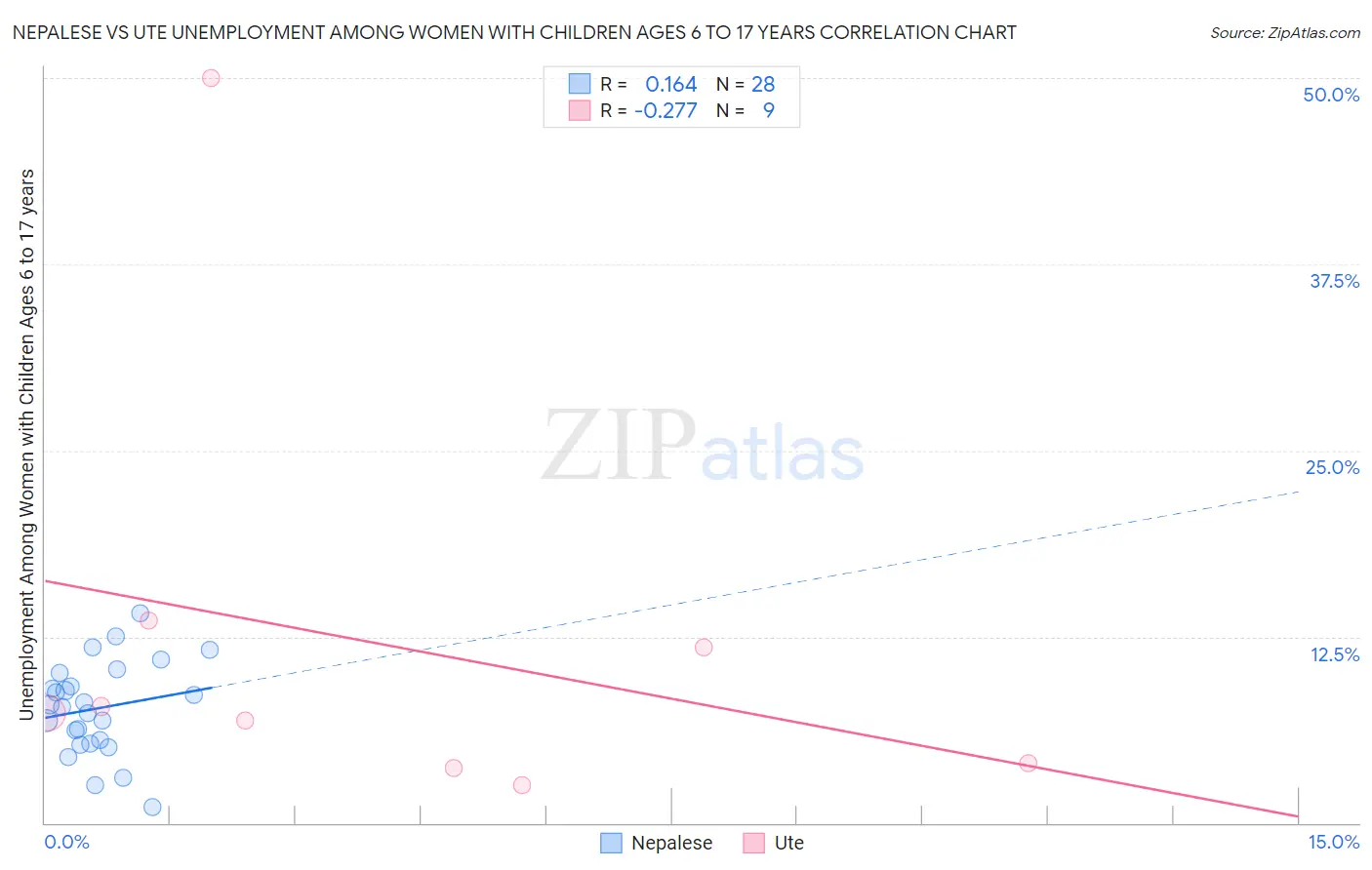Nepalese vs Ute Unemployment Among Women with Children Ages 6 to 17 years
COMPARE
Nepalese
Ute
Unemployment Among Women with Children Ages 6 to 17 years
Unemployment Among Women with Children Ages 6 to 17 years Comparison
Nepalese
Ute
7.7%
UNEMPLOYMENT AMONG WOMEN WITH CHILDREN AGES 6 TO 17 YEARS
100.0/ 100
METRIC RATING
24th/ 347
METRIC RANK
7.0%
UNEMPLOYMENT AMONG WOMEN WITH CHILDREN AGES 6 TO 17 YEARS
100.0/ 100
METRIC RATING
4th/ 347
METRIC RANK
Nepalese vs Ute Unemployment Among Women with Children Ages 6 to 17 years Correlation Chart
The statistical analysis conducted on geographies consisting of 22,673,047 people shows a poor positive correlation between the proportion of Nepalese and unemployment rate among women with children between the ages 6 and 17 in the United States with a correlation coefficient (R) of 0.164 and weighted average of 7.7%. Similarly, the statistical analysis conducted on geographies consisting of 50,489,522 people shows a weak negative correlation between the proportion of Ute and unemployment rate among women with children between the ages 6 and 17 in the United States with a correlation coefficient (R) of -0.277 and weighted average of 7.0%, a difference of 10.1%.

Unemployment Among Women with Children Ages 6 to 17 years Correlation Summary
| Measurement | Nepalese | Ute |
| Minimum | 1.1% | 2.5% |
| Maximum | 14.1% | 50.0% |
| Range | 13.0% | 47.5% |
| Mean | 7.7% | 12.0% |
| Median | 7.9% | 7.4% |
| Interquartile 25% (IQ1) | 5.4% | 3.8% |
| Interquartile 75% (IQ3) | 9.6% | 12.7% |
| Interquartile Range (IQR) | 4.2% | 8.8% |
| Standard Deviation (Sample) | 3.1% | 14.7% |
| Standard Deviation (Population) | 3.0% | 13.9% |
Demographics Similar to Nepalese and Ute by Unemployment Among Women with Children Ages 6 to 17 years
In terms of unemployment among women with children ages 6 to 17 years, the demographic groups most similar to Nepalese are Immigrants from Indonesia (7.7%, a difference of 0.010%), Immigrants from China (7.7%, a difference of 0.39%), Immigrants from India (7.7%, a difference of 0.68%), Immigrants from Singapore (7.7%, a difference of 0.81%), and Filipino (7.6%, a difference of 1.8%). Similarly, the demographic groups most similar to Ute are Okinawan (7.0%, a difference of 0.60%), Tlingit-Haida (7.1%, a difference of 1.1%), Soviet Union (7.1%, a difference of 1.1%), Immigrants from Hong Kong (7.2%, a difference of 2.6%), and Assyrian/Chaldean/Syriac (7.2%, a difference of 2.9%).
| Demographics | Rating | Rank | Unemployment Among Women with Children Ages 6 to 17 years |
| Ute | 100.0 /100 | #4 | Exceptional 7.0% |
| Okinawans | 100.0 /100 | #5 | Exceptional 7.0% |
| Tlingit-Haida | 100.0 /100 | #6 | Exceptional 7.1% |
| Soviet Union | 100.0 /100 | #7 | Exceptional 7.1% |
| Immigrants | Hong Kong | 100.0 /100 | #8 | Exceptional 7.2% |
| Assyrians/Chaldeans/Syriacs | 100.0 /100 | #9 | Exceptional 7.2% |
| Immigrants | Fiji | 100.0 /100 | #10 | Exceptional 7.3% |
| Immigrants | Taiwan | 100.0 /100 | #11 | Exceptional 7.3% |
| Bangladeshis | 100.0 /100 | #12 | Exceptional 7.4% |
| Indonesians | 100.0 /100 | #13 | Exceptional 7.4% |
| Sudanese | 100.0 /100 | #14 | Exceptional 7.4% |
| Puget Sound Salish | 100.0 /100 | #15 | Exceptional 7.5% |
| Immigrants | Burma/Myanmar | 100.0 /100 | #16 | Exceptional 7.5% |
| Cambodians | 100.0 /100 | #17 | Exceptional 7.5% |
| Afghans | 100.0 /100 | #18 | Exceptional 7.6% |
| Filipinos | 100.0 /100 | #19 | Exceptional 7.6% |
| Immigrants | Singapore | 100.0 /100 | #20 | Exceptional 7.7% |
| Immigrants | India | 100.0 /100 | #21 | Exceptional 7.7% |
| Immigrants | China | 100.0 /100 | #22 | Exceptional 7.7% |
| Immigrants | Indonesia | 100.0 /100 | #23 | Exceptional 7.7% |
| Nepalese | 100.0 /100 | #24 | Exceptional 7.7% |